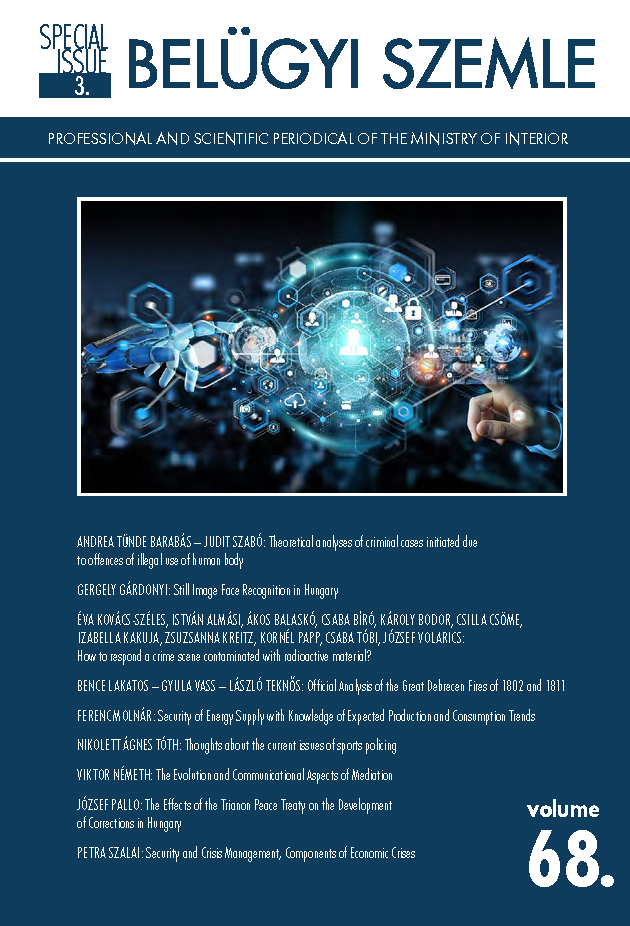Keywords
problem solving consensus building
participatory theory of communication (PTC)
system theory
How to Cite
Abstract
Since mediation, as a form of alternative dispute resolution, has become part of the canonized legal system, it has come to life and has made its own path of development from the 1950s to the present. In this paper, the process and the stages of it are discussed from communicational point of view through the terminology of the PTC. The sections also represent the types of mediation. Relationships and interactions between the types are also the subject of this study, as well as the scopes for certain types. The participatory theory of communication (PTC) allows us to review the development of mediation in the 20th and 21st centuries, from a facilitative mediation to a transformative mediation, according to a unified, transparent framework.
Downloads
Similar Articles
- Ferenc Molnár, Security of Energy Supply with Knowledge of Expected Production and Consumption Trends , Academic Journal of Internal Affairs: Vol. 68 No. 3. ksz. (2020): Special Issue
- Csaba Fenyvesi, The second version of the criminalist pyramid-model , Academic Journal of Internal Affairs: Vol. 62 No. 9 (2014)
- Viktor Németh, Csaba Szabó, The effect of community mediations in the practice through an analysis of two municipal case studies , Academic Journal of Internal Affairs: Vol. 69 No. 6. ksz. (2021): Különszám
- Viktor Németh, Best practices in Hungarian organizational decision-making in the field of integrity management , Academic Journal of Internal Affairs: Vol. 69 No. 3 (2021)
- Csaba Szabó, Proximity is endless , Academic Journal of Internal Affairs: Vol. 69 No. 3 (2021)
- Ildikó Sikó, Béla Danielisz, From crime anxiety to climate fear , Academic Journal of Internal Affairs: Vol. 69 No. 4 (2021)
- Judit Borszéki, Training and output requirements, learning outcomes-based curriculum development and 21st century competences in law enforcement higher education , Academic Journal of Internal Affairs: Vol. 69 No. 5 (2021)
- Laura Schmidt, Criminology MA , Academic Journal of Internal Affairs: Vol. 69 No. 6 (2021)
- Árpád Budavári, The change about that even Radio Yerevan could have reported, or the implementation of law enforcement reforms based on the theory of ‘broken windows’ in Kazakhstan and in Ukraine , Academic Journal of Internal Affairs: Vol. 69 No. 7 (2021)
- Zoltán Hautzinger, The Theory of criminal investigation , Academic Journal of Internal Affairs: Vol. 63 No. 2 (2015)
You may also start an advanced similarity search for this article.
Most read articles by the same author(s)
- Viktor Németh, Csaba Szabó, The characteristics of mediation according to fields of application , Academic Journal of Internal Affairs: Vol. 69 No. 4. ksz. (2021): Különszám
- Viktor Németh, The History of Regulating Mediation , Academic Journal of Internal Affairs: Vol. 70 No. 12 (2022)
- Viktor Németh, Neuroplasticity , Academic Journal of Internal Affairs: Vol. 69 No. 6. ksz. (2021): Különszám
- Viktor Németh, Critical Thinking , Academic Journal of Internal Affairs: Vol. 70 No. 2. ksz. (2022): Special Issue
- Viktor Németh, The international scientific visibility’s means , Academic Journal of Internal Affairs: Vol. 71 No. 4 (2023)
- Viktor Németh, The History of Regulating Mediation , Academic Journal of Internal Affairs: Vol. 71 No. 1.ksz. (2023): Special Issue
- Szandra Fazekas-Pátyodi, Viktor Németh, „Insisting on quality” , Academic Journal of Internal Affairs: Vol. 71 No. 5 (2023)
- Viktor Németh, How We Decide? ... and how should we decide? , Academic Journal of Internal Affairs: Vol. 70 No. 1 (2022)
- Viktor Németh, Best practices in Hungarian organizational decision-making in the field of integrity management , Academic Journal of Internal Affairs: Vol. 69 No. 3 (2021)
- Viktor Németh, COVID-19 The pandemic that never should have happened, and how to stop the next one , Academic Journal of Internal Affairs: Vol. 68 No. 2. ksz. (2020): Special Issue
